供应链管理 第九章练习与答案
- 格式:pdf
- 大小:101.84 KB
- 文档页数:3
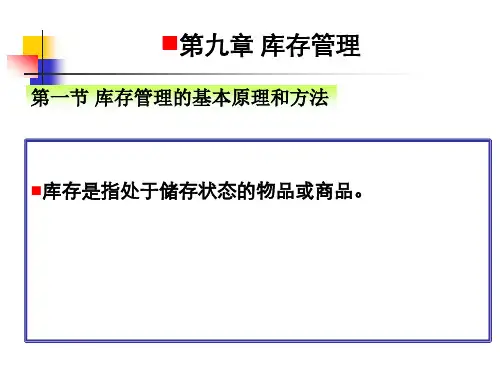
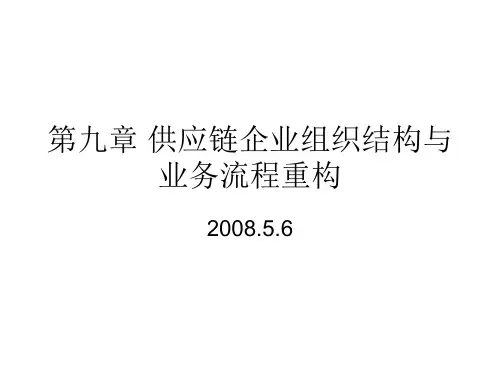
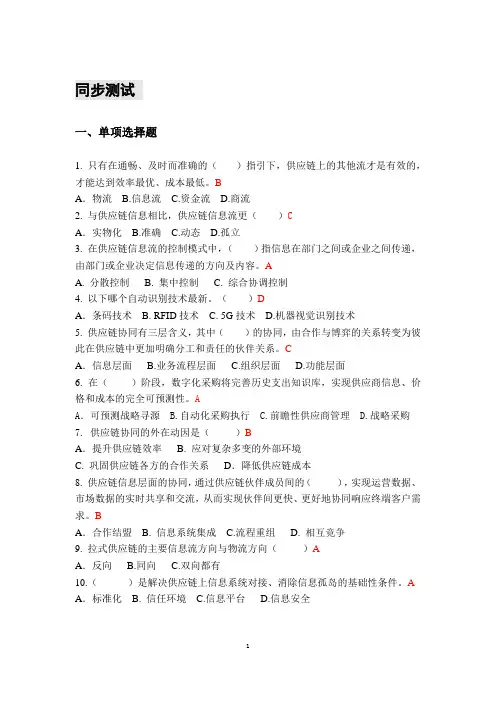
同步测试一、单项选择题1. 只有在通畅、及时而准确的()指引下,供应链上的其他流才是有效的,才能达到效率最优、成本最低。
BA.物流 B.信息流 C.资金流 D.商流2. 与供应链信息相比,供应链信息流更()CA.实物化 B.准确 C.动态 D.孤立3. 在供应链信息流的控制模式中,()指信息在部门之间或企业之间传递,由部门或企业决定信息传递的方向及内容。
AA. 分散控制B. 集中控制C. 综合协调控制4. 以下哪个自动识别技术最新。
()DA.条码技术 B. RFID技术 C. 5G技术 D.机器视觉识别技术5. 供应链协同有三层含义,其中()的协同,由合作与博弈的关系转变为彼此在供应链中更加明确分工和责任的伙伴关系。
CA.信息层面 B.业务流程层面 C.组织层面 D.功能层面6.在()阶段,数字化采购将完善历史支出知识库,实现供应商信息、价格和成本的完全可预测性。
AA.可预测战略寻源 B.自动化采购执行 C.前瞻性供应商管理 D.战略采购7.供应链协同的外在动因是()BA.提升供应链效率 B. 应对复杂多变的外部环境C. 巩固供应链各方的合作关系D.降低供应链成本8. 供应链信息层面的协同,通过供应链伙伴成员间的(),实现运营数据、市场数据的实时共享和交流,从而实现伙伴间更快、更好地协同响应终端客户需求。
BA.合作结盟 B. 信息系统集成 C.流程重组 D. 相互竞争9. 拉式供应链的主要信息流方向与物流方向()AA.反向 B.同向 C.双向都有10.()是解决供应链上信息系统对接、消除信息孤岛的基础性条件。
A A.标准化 B. 信任环境 C.信息平台 D.信息安全二、多项选择题1. 从供应链环节的角度划分,供应链信息包括()。
ABCDA.供应源信息B. 配送与零售信息C.生产信息D.需求信息E.战略信息2. 以下哪些描述了信息在供应链管理中的作用()BCDEA.供应链信息要求准确及时的传递。
B.有助于正确做出库存管理、运输设计、设施网点选址等驱动供应链的管理决策,使供应链运作更有效果。
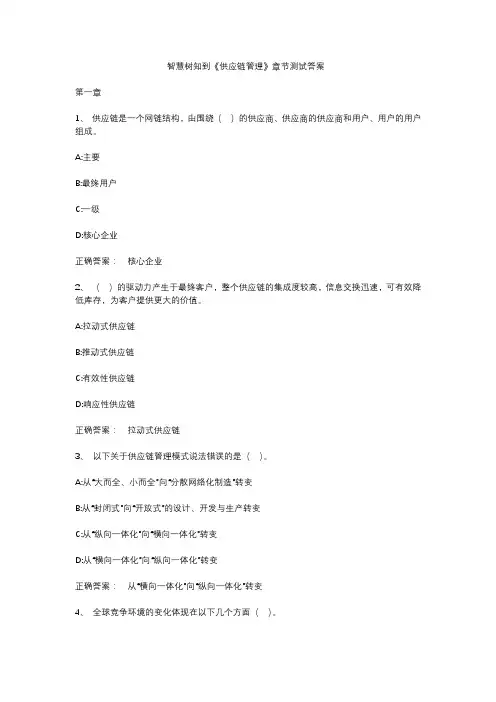
智慧树知到《供应链管理》章节测试答案第一章1、供应链是一个网链结构,由围绕()的供应商、供应商的供应商和用户、用户的用户组成。
A:主要B:最终用户C:一级D:核心企业正确答案:核心企业2、()的驱动力产生于最终客户,整个供应链的集成度较高,信息交换迅速,可有效降低库存,为客户提供更大的价值。
A:拉动式供应链B:推动式供应链C:有效性供应链D:响应性供应链正确答案:拉动式供应链3、以下关于供应链管理模式说法错误的是()。
A:从“大而全、小而全”向“分散网络化制造”转变B:从“封闭式”向“开放式”的设计、开发与生产转变C:从“纵向一体化”向“横向一体化”转变D:从“横向一体化”向“纵向一体化”转变正确答案:从“横向一体化”向“纵向一体化”转变4、全球竞争环境的变化体现在以下几个方面()。
A:全球化B:产品生命周期越来越短C:产品品种数飞速膨胀D:产品价格迅速下跌E:对产品和服务的期望越来越高正确答案:全球化,产品生命周期越来越短,产品品种数飞速膨胀,产品价格迅速下跌,对产品和服务的期望越来越高5、传统管理模式的弊端包括()。
A:增加企业投资负担B:迫使企业从事不擅长的业务活动C:在每个业务领域都具有较强竞争力D:承担丧失市场时机的风险正确答案:增加企业投资负担,迫使企业从事不擅长的业务活动,承担丧失市场时机的风险6、供应链是一条连接供应商到客户的()。
A:物料链B:价值链C:信息链D:资金链正确答案:物料链,价值链,信息链,资金链7、供应链管理的作用是()。
A:提高顾客满意度B:保持市场份额不变C:降低成本D:有效运用固定资产和流动资产E:提高市场竞争力正确答案:提高顾客满意度,降低成本,有效运用固定资产和流动资产,提高市场竞争力8、供应链可以没有核心企业。
()A:对B:错正确答案:错9、供应链管理的主要目标是以系统的观点,对多个职能和多层次供应商进行整合和管理外购、业务流程和物料控制。
()A:对B:错正确答案:对10、推动式供应链的集成度较高,适用于供大于求、客户需求不断变化的市场环境。
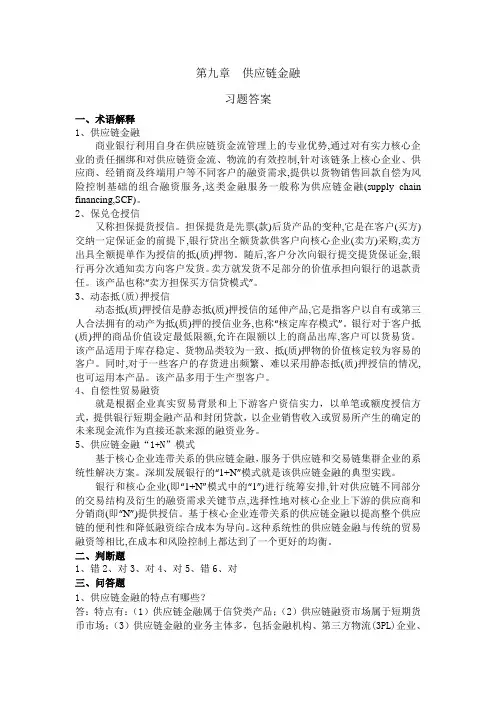
第九章供应链金融习题答案一、术语解释1、供应链金融商业银行利用自身在供应链资金流管理上的专业优势,通过对有实力核心企业的责任捆绑和对供应链资金流、物流的有效控制,针对该链条上核心企业、供应商、经销商及终端用户等不同客户的融资需求,提供以货物销售回款自偿为风险控制基础的组合融资服务,这类金融服务一般称为供应链金融(supply chain financing,SCF)。
2、保兑仓授信又称担保提货授信。
担保提货是先票(款)后货产品的变种,它是在客户(买方)交纳一定保证金的前提下,银行贷出全额货款供客户向核心企业(卖方)采购,卖方出具全额提单作为授信的抵(质)押物。
随后,客户分次向银行提交提货保证金,银行再分次通知卖方向客户发货。
卖方就发货不足部分的价值承担向银行的退款责任。
该产品也称“卖方担保买方信贷模式”。
3、动态抵(质)押授信动态抵(质)押授信是静态抵(质)押授信的延伸产品,它是指客户以自有或第三人合法拥有的动产为抵(质)押的授信业务,也称“核定库存模式”。
银行对于客户抵(质)押的商品价值设定最低限额,允许在限额以上的商品出库,客户可以货易货。
该产品适用于库存稳定、货物品类较为一致、抵(质)押物的价值核定较为容易的客户。
同时,对于一些客户的存货进出频繁、难以采用静态抵(质)押授信的情况,也可运用本产品。
该产品多用于生产型客户。
4、自偿性贸易融资就是根据企业真实贸易背景和上下游客户资信实力,以单笔或额度授信方式,提供银行短期金融产品和封闭贷款,以企业销售收入或贸易所产生的确定的未来现金流作为直接还款来源的融资业务。
5、供应链金融“1+N”模式基于核心企业连带关系的供应链金融,服务于供应链和交易链集群企业的系统性解决方案。
深圳发展银行的“1+N”模式就是该供应链金融的典型实践。
银行和核心企业(即“1+N”模式中的“1”)进行统筹安排,针对供应链不同部分的交易结构及衍生的融资需求关键节点,选择性地对核心企业上下游的供应商和分销商(即“N”)提供授信。
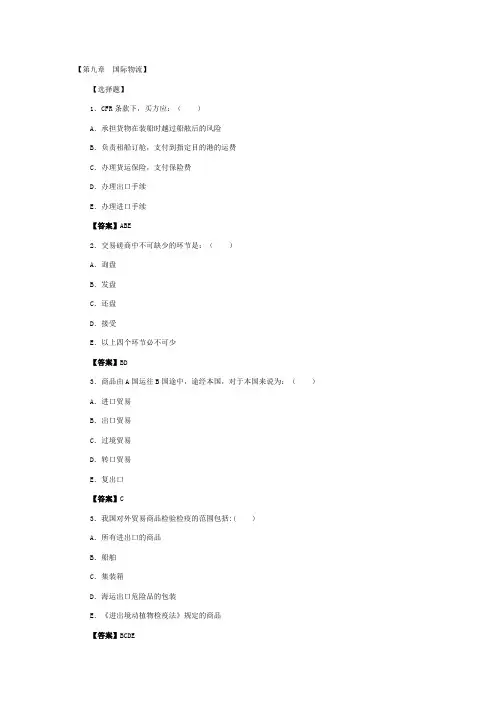
【第九章国际物流】【选择题】1.CFR条款下,买方应:()A.承担货物在装船时越过船舷后的风险B.负责租船订舱,支付到指定目的港的运费C.办理货运保险,支付保险费D.办理出口手续E.办理进口手续【答案】ABE2.交易磋商中不可缺少的环节是:()A.询盘B.发盘C.还盘D.接受E.以上四个环节必不可少【答案】BD3.商品由A国运往B国途中,途经本国,对于本国来说为:()A.进口贸易B.出口贸易C.过境贸易D.转口贸易E.复出口【答案】C3.我国对外贸易商品检验检疫的范围包括:( )A.所有进出口的商品B.船舶C.集装箱D.海运出口危险品的包装E.《进出境动植物检疫法》规定的商品【答案】BCDE5.出境货物最迟于报关或装运前天报检.()A.7B.15C.20D.30E.60【答案】A6.对一般的进出口货物报关时需交验以下哪些单证?()A.进出口货物报关单B.发票C.商品检验证明D.减免税或免检证明E.提货单、装货单或运单【答案】ABCDE7.海上风险包括:( )A.恶劣气候B.流冰C.船舶搁浅D.偷窃E.战争【答案】ABC8.根据我国现行的《海洋货物运输保险条款》的规定,基本险别包括:( )A.平安险B.偷窃、提货不着险C.水渍险D.一切险E.串味险【答案】ACD9.平安险的承保责任范围包括:()A.由于自然灾害和运输工具发生意外事故,造成被保险货物的全部或部分损失B.由于运输工具遭遇搁浅、触礁、沉没、互撞、与流冰或其他物体碰撞造成被保险货物的全部或部分损失C.在装卸转船过程中,被保险货物一件或数件落海所造成的全部损失或部分损失D.货物在运输过程中,因一般外来原因所造成的被保险货物的全部或部分损失E.货物在运输过程中,因特殊外来原因所造成的被保险货物的全部或部分损失【答案】BC10.出口货物的报关报检等工作可由()办理。
A.出口商B.进口商C.国际货运代理D.理货机构E.船方【答案】AC11.以下单证具有物权凭证作用的有:()A.提单B.提货单C.货协运单D.航空货运单E.多式联运单据【答案】A12.根据货物外表状况有无不良批注可将提单分为:()A.记名提单B.指示提单C.不记名提单D.清洁提单E.不清洁提单【答案】DE13.国际海上货物运输有关国际公约有:()A.《海牙规则》B.《海牙/维斯比规则》C.《汉堡规则》D.《华沙公约》E.《海牙议定书》【答案】ABC13.国际集装箱运输中,拼箱货的装拆箱业务是在进行的。
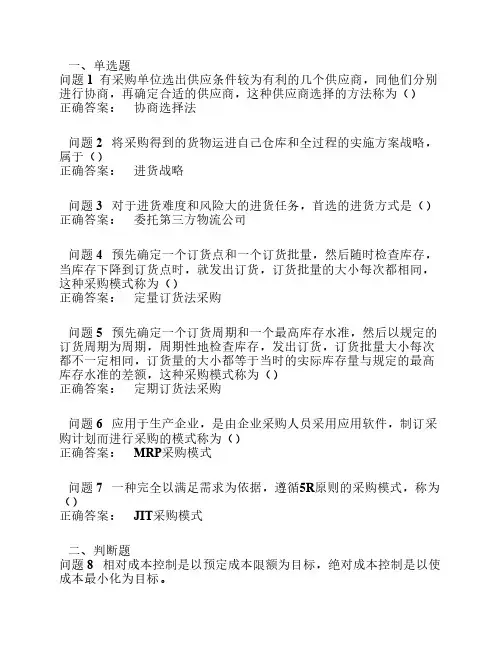
一、单选题问题 1 有采购单位选出供应条件较为有利的几个供应商,同他们分别进行协商,再确定合适的供应商,这种供应商选择的方法称为()正确答案:协商选择法问题 2 将采购得到的货物运进自己仓库和全过程的实施方案战略,属于()正确答案:进货战略问题 3 对于进货难度和风险大的进货任务,首选的进货方式是()正确答案:委托第三方物流公司问题 4 预先确定一个订货点和一个订货批量,然后随时检查库存,当库存下降到订货点时,就发出订货,订货批量的大小每次都相同,这种采购模式称为()正确答案:定量订货法采购问题 5 预先确定一个订货周期和一个最高库存水准,然后以规定的订货周期为周期,周期性地检查库存,发出订货,订货批量大小每次都不一定相同,订货量的大小都等于当时的实际库存量与规定的最高库存水准的差额,这种采购模式称为()正确答案:定期订货法采购问题 6 应用于生产企业,是由企业采购人员采用应用软件,制订采购计划而进行采购的模式称为()正确答案: MRP采购模式问题 7 一种完全以满足需求为依据,遵循5R原则的采购模式,称为()正确答案: JIT采购模式二、判断题问题 8 相对成本控制是以预定成本限额为目标,绝对成本控制是以使成本最小化为目标。
正确答案:错问题 9 根据品种的市场性质和需求性质而选择合适的采购战略称为品种战略。
正确答案:对问题 10 一个完整的招标采购包括:招标,投标、开标、评标、决标和签订合同。
正确答案:对问题 11 企业采购战略,是指企业采购所采用的带有指导性、全局性、长远性的基本运作方案。
正确答案:对问题 12 订货谈判战略包括采购的品种规格、数量、质量、价格、服务和风险分摊、责任权利和义务等。
正确答案:对三、名词解释问题 13 采购/供应管理正确答案:采购/供应管理是处理企业与供应市场之间的各类业务活动,如采购、库存、运输、订单处理等,但不包括供应商的供应商,即只与第一级供应商的业务有关。
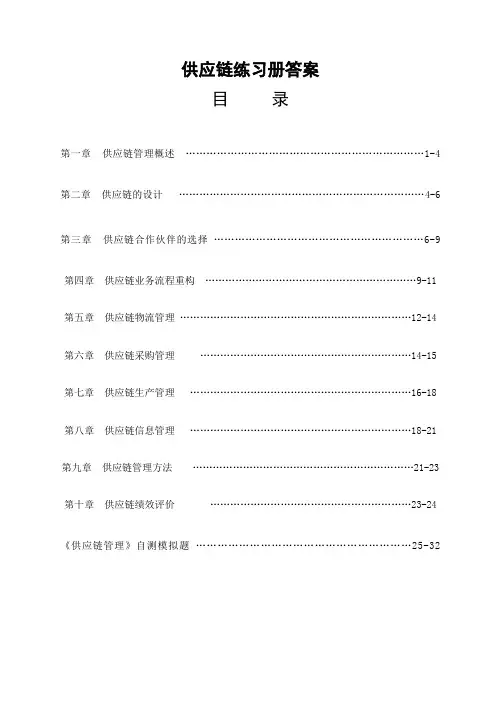
供应链练习册答案目录第一章供应链管理概述……………………………………………………………1-4 第二章供应链的设计………………………………………………………………4-6 第三章供应链合作伙伴的选择……………………………………………………6-9 第四章供应链业务流程重构………………………………………………………9-11 第五章供应链物流管理……………………………………………………………12-14 第六章供应链采购管理………………………………………………………14-15 第七章供应链生产管理…………………………………………………………16-18 第八章供应链信息管理…………………………………………………………18-21 第九章供应链管理方法…………………………………………………………21-23 第十章供应链绩效评价……………………………………………………23-24 《供应链管理》自测模拟题……………………………………………………25-32第一章供应链管理概述一、名词解释扩展企业: 是一个概念性的组织单元或系统,它包括采购公司和供应商(一个或多个),他们通过紧密合作来实现最大化的利润分配。
供应链:生产和流通过程中,涉及将产品或服务提供给最终用户活动的上游与下游企业所形成的网链结构。
.供应链管理是一种集成的管理思想和方法,它执行供应链中从供应商到最终用户的物流的计划和控制等职能。
二、选择1、供应链的特征主要有面向用户需求和(abce )。
a 交叉性b 增值性c 动态性d 保值性e 复杂性2、构成企业核心竞争能力的要素包括( BCDE )。
a产品b员工拥有的技能 c 企业的技术体系d 管理体系e 价值观3、在供应链中表现为单向流动的是( ABC )。
a物流b资金流 c 服务流 d 信息流 e 消费流三、判断1、供应链管理的具体目标是通过调和总成本最低化、总库存最少化、总周期时间最短化以及物流质量最优化等目标之间的冲突,实现供应链绩效最大化。

供应链管理课后习题答案第一章、供应链管理导论1.供应链的结构特征是什么?将供应商、制造商、分销商、零售商、直到最终用户连成一个整体的功能网链结构。
2.何谓供应链管理?简述供应链管理与传统企业管理的区别和联系。
供应链管理就是使以核心企业为中心的供应链运作达到最优化,以最低的成本,另供应链从采购开始,到满足最终用户的所有过程,包括工作流、实物流、信息流、资金流等均高效率运作,把合适的产品,以合理的价格,及时准确的送到消费者手中。
区别:①传统企业的运营思想是生产是为了销售,而供应链企业运营的思想是按订单准时生产、快速响应客户需求②传统企业的管理手段是控制库存、降低库存成本,而供应链管理的手段是供应链企业协同创新、共创价值③传统企业提高生产效率的主要方法是扩大批量、增加规模效应,而供应链企业提高效率的主要方法是提升企业的柔性和敏捷性联系:供应链管理主要是以物流运行作为流程的,是开放性的,传统企业只是供应链管理中的一个环节,是闭环的。
3.供应链管理的关键在于实现企业内部及企业之间资源的集成。
从这个角度,分析互联网在供应链管理中的重要地位。
从管理难度的角度:现在的客户关系管理、企业资源计划等系统使得管理更加容易,尤其是对于一些全球性企业和跨区域企业从效率的角度:通过IT系统,从客户需求到计划、采购、生产、运输等供应链的整个过程更加迅速、高效。
当然也包括上下游企业和核心企业之间的沟通。
从成本的角度:管理难度下降,效率提升,这实际上降低了企业的成本4.电子商务将成为21世纪最主要的商业模式之一,它将对企业传统的业务流程带来巨大变革。
请阐述供应链管理对我国企业成功实施电子商务的重要意义。
基于电子商务的供应链的管理的主要内容涉及订单处理、生产组织、采购管理、运输与配送管理、库存管理、客户服务、支付管理等,供应链管理可促进电子商务的发展,使资源在供应链网络中合理流动,来缩短交货周期、降低库存,并且通过提供自助交易的自助式服务以降低成本,提高速度和精确性,增强企业竞争力。
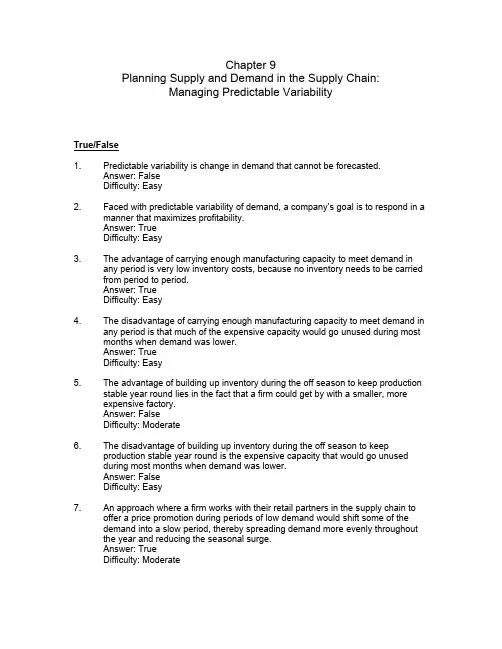
Chapter 9Planning Supply and Demand in the Supply Chain:Managing Predictable VariabilityTrue/False1.Predictable variability is change in demand that cannot be forecasted.Answer: FalseDifficulty: Easy2.Faced with predictable variability of demand, a company’s goal is to respond in amanner that maximizes profitability.Answer: TrueDifficulty: Easy3.The advantage of carrying enough manufacturing capacity to meet demand inany period is very low inventory costs, because no inventory needs to be carried from period to period.Answer: TrueDifficulty: Easy4.The disadvantage of carrying enough manufacturing capacity to meet demand inany period is that much of the expensive capacity would go unused during most months when demand was lower.Answer: TrueDifficulty: Easy5.The advantage of building up inventory during the off season to keep productionstable year round lies in the fact that a firm could get by with a smaller, moreexpensive factory.Answer: FalseDifficulty: Moderate6.The disadvantage of building up inventory during the off season to keepproduction stable year round is the expensive capacity that would go unusedduring most months when demand was lower.Answer: FalseDifficulty: Easy7.An approach where a firm works with their retail partners in the supply chain tooffer a price promotion during periods of low demand would shift some of thedemand into a slow period, thereby spreading demand more evenly throughoutthe year and reducing the seasonal surge.Answer: TrueDifficulty: Moderate8.With supply and demand management decisions being made independently, it iseasier to coordinate the supply chain, thereby increasing profit.Answer: FalseDifficulty: Moderate9. A firm can vary supply of product by controlling production capacity andinventory.Answer: TrueDifficulty: Easy10. A firm that uses flexible work hours from the workforce to manage capacity tobetter meet demand is using a seasonal workforce.Answer: FalseDifficulty: Moderate11.Scheduling the workforce so that the available capacity better matches demandis using time flexibility from the workforce.Answer: TrueDifficulty: Moderate12.The use of a part-time workforce to increase the capacity flexibility by enablingthe firm to have more people at work during peak periods is designing productflexibility into the production processes.Answer: FalseDifficulty: Moderate13. A firm that uses a temporary workforce during the peak season to increasecapacity to match demand is using a seasonal workforce.Answer: TrueDifficulty: Easy14.The use of dual facilities to manage capacity may be hard to sustain if the labormarket is tight.Answer: FalseDifficulty: Hard15. A firm that purchases peak production capability from other companies so thatinternal production remains level and can be done cheaply is usingsubcontracting.Answer: TrueDifficulty: Easy16. A firm that builds dedicated facilities to produce a relatively stable output ofproducts over time in a very efficient manner and purchases peak productioncapability from other companies is using subcontracting.Answer: FalseDifficulty: Hard17. A firm that has production lines whose production rate can easily be varied tomatch demand has designed product flexibility into the production processes.Answer: TrueDifficulty: Easy18.The use of a seasonal workforce requires that the workforce be multi-skilled andeasily adapt to being moved from line to line.Answer: ModerateDifficulty: Hard19.The use of common components across multiple products, with each producthaving predictably variable demand, will result in the demand for the components being relatively constant.Answer: TrueDifficulty: Moderate20.When most of the products a firm produces have the same peak demandseason, the use of common components to create relatively constant overalldemand in the components is feasible.Answer: FalseDifficulty: Moderate21.When most of the products a firm produces have the same peak demandseason, it is necessary to build products during the off season that have morepredictable demand.Answer: TrueDifficulty: Easy22.Operations usually makes the promotion and pricing decisions.Answer: FalseDifficulty: Easy23.Maximizing revenue is typically the objective when marketing and sales make thepromotion and pricing decisions.Answer: TrueDifficulty: Easy24.Pricing decisions based only on revenue considerations often result in anincrease in overall profitability.Answer: FalseDifficulty: Moderate25.The combination of pricing and aggregate planning (both demand and supplymanagement) can be used to maximize supply chain profitability.Answer: TrueDifficulty: Moderate26.When performing aggregate planning, the goal of all firms in the supply chainshould be to maximize individual firm profits.Answer: FalseDifficulty: Moderate27.Determining how profits will be allocated to different members of the supply chainis a key to successful collaboration.Answer: TrueDifficulty: Moderate28.In general, as the fraction of increased demand coming from forward buyinggrows, offering the promotion during the peak demand period becomes moreattractive.Answer: FalseDifficulty: Moderate29.Offering a promotion during a peak period that has significant forward buyingcreates even more variable demand than before the promotion.Answer: TrueDifficulty: Easy30.Average inventory decreases if a promotion is run during the peak period andincreases if the promotion is run during the off-peak period.Answer: FalseDifficulty: Easy31.Promoting during a peak demand month may decrease overall profitability if asignificant fraction of the demand increase results from a forward buy.Answer: TrueDifficulty: Hard32.As forward buying becomes a smaller fraction of the demand increase from apromotion, it is less profitable to promote during the peak period.Answer: FalseDifficulty: Hard33.As the product margin declines, promoting during the peak demand periodbecomes less profitable.Answer: TrueDifficulty: Easy34.When faced with seasonal demand, a firm should use a combination of pricing(to manage demand) and production and inventory (to manage supply) toimprove profitability.Answer: TrueDifficulty: ModerateMultiple Choice1.Predictable variability isa.change in demand that can be forecasted.b.change in demand that cannot be forecasted.c.change in demand that has been planned.d.change in demand that has been scheduled.e.all of the aboveAnswer: aDifficulty: Easy2.Which of the following is not a problem caused by products experiencingpredictable variability of demand?a.high levels of stockouts during peak demandb.high levels of excess inventory during periods of low demandc.increased responsiveness of the supply chaind.increased costs in the supply chaine.decreased responsiveness of the supply chainAnswer: cDifficulty: Easy3. A firm can handle predictable variability by managinga.supply using capacity, inventory, trade promotions, and backlogs.b.supply using capacity, inventory, subcontracting, and backlogs.c.demand using short-term price discounts and trade promotions.d. a and c onlye. b and c onlyAnswer: eDifficulty: Easy4.Seasonal demand can be met bya.maintaining enough manufacturing capacity to meet demand in anyperiod.b.building up inventory during the off season to meet demand during peakseasons.c.offering a price promotion during periods of low demand to shift some ofthe demand into a slow period.d.all of the abovee. a and b onlyAnswer: dDifficulty: Moderate5.The advantage of maintaining enough manufacturing capacity to meet demand inany period isa.very low inventory costs because inventory needs to be carried fromperiod to period.b.very low inventory costs because no inventory needs to be carried fromperiod to period.c.very high inventory costs because no inventory needs to be carried fromperiod to period.d.very high inventory costs because expensive capacity would go unusedduring most months when demand was lower.e.none of the aboveAnswer: bDifficulty: Moderate6.The disadvantage of maintaining enough manufacturing capacity to meetdemand in any period isa.much of the expensive capacity would go unused during most monthswhen demand was lower.b.the expensive capacity would be used consistently throughout the year.c.most of the expensive capacity would still be used during most monthswhen demand was lower.d.very low inventory costs because no inventory needs to be carried fromperiod to period.e.None of the above are true.Answer: aDifficulty: Moderate7.The advantage of building up inventory during the off season to meet demandduring peak seasons and keep production stable year round isa.very low inventory costs because no inventory needs to be carried fromperiod to period.b.much of the expensive capacity would go unused during most monthswhen demand was lower.c.in the fact that a firm could get by with a smaller, less expensive factory.d.in the fact that a firm could get by with a larger, more expensive factory.e.None of the above are true.Answer: cDifficulty: Moderate8.The disadvantage of building up inventory during the off season to meet demandduring peak seasons and keep production stable year round isa.very low inventory costs because no inventory needs to be carried fromperiod to period.b.very high inventory costs because inventory needs to be carried from periodto period.c.in the fact that a firm could get by with a smaller, less expensive factory.d.in the fact that a firm could get by with a larger, more expensive factory.e.None of the above are true.Answer: bDifficulty: Moderate9.The advantage of offering a price promotion during periods of low demand toshift some of the demand into a slow period isa. a demand pattern that is less expensive to supply.b.very high inventory costs because inventory needs to be carried fromperiod to period.c.in the fact that a firm could get by with a smaller, more expensive factory.d.much of the expensive capacity would go unused during most monthswhen demand was lower.e.all of the aboveAnswer: aDifficulty: Moderatepanies typically divide the task of supply and demand so thata.Marketing manages demand and Operations manages supply.b.Marketing manages supply and Operations manages demand.c.Marketing manages demand and supply.d.Operations manages demand and supply.e.none of the aboveAnswer: aDifficulty: Easy11.With supply and demand management decisions being made independently,a.it is increasingly difficult to coordinate the supply chain, therebyincreasing profit.b.it is increasingly difficult to coordinate the supply chain, therebydecreasing profit.c.it is easier to coordinate the supply chain, thereby decreasing profit.d.it is easier to coordinate the supply chain, thereby increasing profit.e.none of the aboveAnswer: bDifficulty: Moderate12. A firm can vary supply of product by controllinga.production capacity and inventory.b.production capacity and price promotions.c.price promotions and inventory.d.production capacity and inventory promotions.e.none of the aboveAnswer: aDifficulty: Moderate13.Which of the following is not an approach that firms can use when managingcapacity to meet predictable demand variability?a.time flexibility from workforcee of seasonal workforcee of subcontractinge of dual facilities—dedicated and flexibleing common components across multiple productsAnswer: eDifficulty: Easy14.The capacity management approach that uses flexible work hours from theworkforce to manage capacity to better meet demand isa.time flexibility from workforce.e of seasonal workforce.e of subcontracting.e of dual facilities—dedicated and flexible.e.designing product flexibility into the production processes.Answer: aDifficulty: Moderate15.The capacity management approach that uses a temporary workforce during thepeak season to increase capacity to match demand isa.time flexibility from workforce.b.the use of seasonal workforce.c.the use of subcontracting.d.the use of dual facilities—dedicated and flexible.e.designing product flexibility into the production processes.Answer: bDifficulty: Easy16.The capacity management approach where a firm purchases peak productionfrom another firm so that internal production remains level and can be donecheaply isa.time flexibility from workforce.b.the use of seasonal workforce.c.the use of subcontracting.d.the use of dual facilities—dedicated and flexible.e.designing product flexibility into the production processes.Answer: cDifficulty: Moderate17.The capacity management approach where a firm builds facilities to produce arelatively stable output of products over time in a very efficient manner andfacilities to produce a widely varying volume and variety of products, but at ahigher unit cost isa.time flexibility from workforce.b.the use of seasonal workforce.c.the use of subcontracting.d.the use of dual facilities—dedicated and flexible.e.designing product flexibility into the production processes.Answer: dDifficulty: Easy18.The capacity management approach where a firm has production lines whoseproduction rate can easily be varied to match demand isa.time flexibility from workforce.b.the use of seasonal workforce.c.the use of subcontracting.d.the use of dual facilities—dedicated and flexible.e.designing product flexibility into the production processes.Answer: eDifficulty: Moderate19.Which approach to capacity management may be hard to sustain if the labormarket is tight?a.time flexibility from workforcee of seasonal workforcee of subcontractinge of dual facilities—dedicated and flexiblee.designing product flexibility into the production processesAnswer: bDifficulty: Moderate20.Which approach to capacity management makes use of spare plant capacity thatexists in the form of hours when the plant is not operational?a.time flexibility from workforcee of seasonal workforcee of subcontractinge of dual facilities—dedicated and flexiblee.designing product flexibility into the production processesAnswer: aDifficulty: Moderate21.Which approach to capacity management makes use of overtime, which is variedto match the variation in demand?a.time flexibility from workforcee of seasonal workforcee of subcontractinge of dual facilities—dedicated and flexiblee.designing product flexibility into the production processesAnswer: aDifficulty: Easy22.Which approach to capacity management would schedule the workforce so thatthe available capacity better matches demand?a.time flexibility from workforcee of seasonal workforcee of subcontractinge of dual facilities—dedicated and flexiblee.designing product flexibility into the production processesAnswer: aDifficulty: Easy23.Which approach to capacity management would use a part-time workforce toincrease capacity flexibility by enabling the firm to have more people at workduring peak periods?a.time flexibility from workforcee of seasonal workforcee of subcontractinge of dual facilities—dedicated and flexiblee.designing product flexibility into the production processesAnswer: aDifficulty: Moderate24.The key to which capacity management approach would involve having bothvolume (fluctuating demand from a manufacturer) and variety flexibility (demand from several manufacturers) to be sustainable?a.time flexibility from workforcee of seasonal workforcee of subcontractinge of dual facilities—dedicated and flexiblee.designing product flexibility into the production processesAnswer: cDifficulty: Hard25.Which approach to capacity management would require that the workforce bemulti-skilled and easily adapt to being moved from line to line?a.time flexibility from workforcee of seasonal workforcee of subcontractinge of dual facilities—dedicated and flexiblee.designing product flexibility into the production processesAnswer: eDifficulty: Moderate26.Which approach to capacity management would use production machinery thatcan be changed easily from producing one product to another?a.time flexibility from workforcee of seasonal workforcee of subcontractinge of dual facilities—dedicated and flexiblee.designing product flexibility into the production processesAnswer: eDifficulty: Moderate27.Which approach to capacity management would only be effective if the overalldemand across all the products is relatively constant?a.time flexibility from workforcee of seasonal workforcee of subcontractinge of dual facilities—dedicated and flexiblee.designing product flexibility into the production processesAnswer: eDifficulty: Hard28.Which of the following is an approach that firms can use when managinginventory to meet predictable demand variability?a.time flexibility from workforcee of seasonal workforcee of subcontractinge of dual facilities—dedicated and flexibleing common components across multiple productsAnswer: eDifficulty: Moderate29.When a firm designs common components used in multiple products, with eachproduct having predictably variable demand, they are trying toa.develop relatively constant overall demand.e a seasonal workforce.c.build inventory of high demand or predictable demand products.e subcontracting.e dual facilities—dedicated and flexible.Answer: dDifficulty: Easy30.When most of the products a firm produces have the same peak demandseason, in order to meet predictable variability with inventory, it muste common components across multiple products.e a seasonal workforce.c.build inventory of high demand or predictable demand products.e subcontracting.e dual facilities—dedicated and flexible.Answer: cDifficulty: Moderate31.Supply chains can influence demand by usinga.production capacity and inventory.b.pricing and other promotions.c.price promotions and inventory.d.production capacity and inventory promotions.e.production capacity and other promotions.Answer: bDifficulty: Moderate32.The pricing and promotion decisions are often made bya.marketing and sales.b.marketing and operations.c.operations and sales.d.marketing, operations, and sales.e.marketing and operations without sales.Answer: aDifficulty: Moderate33.The promotion and pricing decisions made by marketing and sales typically havethe objective ofa.maximizing profitability.b.minimizing profitability.c.minimizing revenue.d.maximizing revenue.e.maximizing profitability across the supply chain.Answer: dDifficulty: Hard34.Pricing decisions based only on revenue considerations often result ina. a decrease in overall profitability.b.an increase in overall profitability.c. a decrease in overall revenue.d. a decrease in supply chain revenue.e.an increase in supply chain profitability.Answer: aDifficulty: Moderate35.The combination of pricing and aggregate planning (both demand and supplymanagement) can be used toa.maximize customer orders.b.minimize customer orders.c.maximize supply chain profitability.d.minimize supply chain profitability.e.None of the above are accurate.Answer: cDifficulty: Easy36.When performing aggregate planning, the goal of all firms should be toa.minimize company profits.b.maximize company profits.c.minimize supply chain profits.d.maximize supply chain profits.e.All of the above are accurate.Answer: dDifficulty: Moderate37.When planning, the goal of all firms in the supply chain should be to maximizesupply chain profits becausea.this leaves them less profit to divide among themselves.b.this leaves them more profit to divide among themselves.c.this outcome leaves them more profit to pay tax on.d.this outcome will increase their charitable giving.e.none of the aboveAnswer: bDifficulty: Easy38.One key to successful collaboration when the supply chain is performingaggregate planning isa.determining how losses will be allocated to different members of thesupply chain.b.determining how profits will be allocated to different members of thesupply chain.c.determining how labor will be allocated to different members of the supplychain.d.determining how customers will be allocated to different members of thesupply chain.e.none of the aboveAnswer: bDifficulty: Moderate39.Which of the following is not a key factor influencing the timing of a tradepromotion?a.impact of the promotion on demandb.product marginsc.cost of holding inventoryd.cost of changing capacitye.none of the aboveAnswer: eDifficulty: Moderate40.Which of the following is not a factor that would result in increased demand froma trade promotion?a.market growthb.stealing sharec.forward sellingd.forward buyinge.All of the above are factors in increased demand.Answer: cDifficulty: Hard41.An increase in consumption of the product either from new or existing customersisa.market growth.b.stealing share.c.forward selling.d.forward buying.e.none of the aboveAnswer: aDifficulty: Easy42.Customers substituting the firm’s product for a competitor’s product isa.market growth.b.stealing share.c.forward selling.d.forward buying.e.none of the aboveAnswer: bDifficulty: Easy43.Customers moving up future purchases to the present isa.market growth.b.stealing share.c.forward selling.d.forward buying.e.none of the aboveAnswer: dDifficulty: Easy44.In general, as the fraction of increased demand coming from forward buyinggrows, offering the promotion during the peak demand period becomesa.less attractive.b.more attractive.c.more profitable.d.less significant.e.none of the aboveAnswer: aDifficulty: Moderate45.Offering a promotion during a peak period that has significant forward buyinga.creates a desirable demand pattern.b.creates a demand pattern less costly to serve.c.creates a demand pattern even more costly to serve.d.shifts demand from the peak period to the slow period.e.shifts demand to a more desirable period.Answer: cDifficulty: Hard46.Average inventorya.increases if a promotion is run during the peak period.b.increases if a promotion is run during the off-peak period.c.decreases if a promotion is run during the peak period.d.decreases if a promotion is run during the off-peak period.e.both a and dAnswer: bDifficulty: Moderate47.Promoting during a peak demand month may decrease overall profitability ifa. a small fraction of the demand increase results from a forward buy.b.any of the demand increase results from a forward buy.c. a significant fraction of the demand increase results from a forward buy.d.none of the abovee.all of the aboveAnswer: cDifficulty: Hard48.As the product margin declines, promoting during the peak demand periodbecomesa.less profitable.b.more profitable.c.less of a risk.d.more desirable.e.none of the aboveAnswer: aDifficulty: HardEssay/Problems1.Discuss how a firm can respond to predictable variability of demand in the supplychain.Answer: Faced with predictable variability, a company’s goal is to respond in amanner that maximizes profitability. A firm must choose how to handlepredictable variability by utilizing techniques in two broad categories:1. Manage supply using capacity, inventory, subcontracting, and backlogs2. Manage demand using short-term price discounts and trade promotionsThe use of these tools enables the supply chain to greatly increase its profitability because it is able to match supply and demand in a much more coordinatedfashion. One way to meet seasonal demand requires carrying enoughmanufacturing capacity to meet demand in any period. The advantage of thisapproach is very low inventory costs, because no inventory needs to be carriedfrom period to period. The disadvantage, however, is that much of the expensive capacity would go unused during most months when demand was lower.Another approach to meeting demand would be to build up inventory during theoff season to keep production stable year round. The advantage of this approach lies in the fact that a firm could get by with a smaller, less expensive factory. High inventory carrying costs, however, make this alternative expensive. A thirdapproach would be for a firm to work with their retail partners in the supply chain to offer a price promotion during periods of low demand. This promotion shiftssome of the demand into a slow period, thereby spreading demand more evenly throughout the year and reducing the seasonal surge. Such a demand pattern is less expensive to supply. A company needs to decide which alternativemaximizes their profitability.Often companies divide the task of supply and demand management betweendifferent functions. Marketing typically manages demand and Operations typically manages supply. At a higher level, supply chains suffer from this phenomenon as well, with retailers independently managing demand and manufacturersindependently managing supply. With supply and demand managementdecisions being made independently, it is increasingly difficult to coordinate thesupply chain, thereby decreasing profit. Therefore, maximizing profitabilitydepends on these decisions being made in a coordinated fashion and requiressupply chain partners to work together across enterprises.Difficulty: Hard2.Discuss the approaches that can be used to manage capacity to meetpredictable variability of demand.Answer: When managing capacity to meet predictable variability, firms use acombination of the following approaches:• Time flexibility from workforce: In this approach, a firm uses flexible work hours from the workforce to manage capacity to better meet demand. In manyinstances, plants do not operate continually and are left idle during portions of the day or week. Therefore, spare plant capacity exists in the form of hours when the plant is not operational. Many plants do not run three shifts, so the existingworkforce could work overtime during peak periods to produce more to meetdemand. If demand fluctuates by day of the week or week of the month and theworkforce is willing to be flexible, a firm may schedule the workforce so that theavailable capacity better matches demand. In such settings, use of a part-timeworkforce may further increase the capacity flexibility by enabling the firm to have more people at work during peak periods.• Use of seasonal workforce: In this approach, a firm uses a temporary workforce during the peak season to increase capacity to match demand. This approachmay be hard to sustain if the labor market is tight.• Use of subcontracting: In this approach, a firm subcontracts peak production so that internal production remains level and can be done cheaply. With thesubcontractor handling the peaks, the company is able to build a relativelyinflexible but low-cost facility where the production rates are kept relativelyconstant (other than variations that arise from the use of overtime). Peaks aresubcontracted out to facilities that are more flexible. A key here is the availability of relatively flexible subcontractor capacity. The subcontractor can often provide。

供应链管理(第三版)章节练习题题库及答案第一章供应链认知(一)判断题(1)供应链不仅是一条连接供应商到用户的物料链、信息链、资金链,而且还是一条增值链。
(T )(2)传统管理模式是以规模化需求和区域性的卖方市场为决策背景,通过规模效应降低成本,获得效益。
( F )(3)供应链管理这一名词最早出现于20世纪80年代,最初是由咨询业提出的。
(T )(4)让最终顾客更满意是供应链全体成员的共同目标,顾客满意的实质是顾客获得超出他们承担的产品价格以上的那部分“价值”。
(T )(5)供应链管理是以同步化、集成化生产计划为指导,以各种信息技术为支持,尤其以Internet/Intranet为依托。
(T )(6)供应链管理整体成本最小化意味着每个节点企业的成本都是最小。
( F )(7)从成本方面来看,供应链管理是通过注重产品最终成本来优化供应链的。
(T )(8)由于供应链节点企业有一个共同的追求目标,所以它们之间不再有竞争性。
(F )(9)供应链管理中的“零库存”就是指节点企业的库存为零。
( F )(10)从系统的观点出发,改进服务、缩短时间、提高品质与减少库存、降低成本是可以兼得的。
(T )二、单选题1、供应链是(C)结构。
A、直链B、支链C、网链D、环状2、供应链节点企业之间是一种(A )关系。
A、需求与供应B、支配C、平等D、利益3、供应链管理因企业战略和适应市场需求变化的需要,链上节点企业需要动态地更新,这就使得供应链具有明显的(B )。
A、复杂性B、动态性C、交叉性D、灵活性4、从20世纪80年代初到20世纪90年代初供应链管理处于(A )。
A、初级阶段B、发展阶段C、成熟阶段D、建设阶段5、按照道格拉斯·兰伯特的思想,企业主动召回有问题的已售商品,属于供应链业务流程的( B )程序?A、订单配送B、反向物流(回流)C、需求管理D、制造流程管理三、多选题1、传统“纵向一体化”管理模式存在的弊端有(ABCD )。
供应链管理习题答案.docC.供应链与供应链D.供应链与企业C.产品的不确定性A.物料链B.信息链C.资金链3.供应链中需求变异放大的原因是(ABCD )A.需求预测修正B.订货批量决策乏合作供应链的结构模型主要有:(AB )D.增值链C.短缺博奕D.价格波动E.缺第一章供应链概述1.供应链随目标的转变而转变,随服务方式的变化而变化,这属于供应链的(D )。
A.时代性B.协调性C.复杂性D.动态性2.将供应链划分为平衡的供应链和倾斜的供应链,是根据(A )划分的。
A.供应链容量与用户需求的关系B.供应链存在的稳定性C.供应链的发展进程D.供应链的功能3.从供应链的结构模型可以看出,节点企业和节点企业之间是一种(A )关系。
A.需求与供应B.支配C.平等D.利益4.对市场的响应速度而言,牛鞭效应表明,越是处于供应链后端,企业响应速度(B )BA.越快B.越慢C. 一般D.无影响5.英国著名物流管理专家马丁?克里斯托夫说:“21世纪的竞争不是企业和企业之间的竞争,而是( C )之间的竞争。
”A.企业内部B.供应链内部二、多选题1.供应链的不确定性主要来源于(ABD )A.供应商的不确定性B.生产者的不确定性D.顾客不确定性E.库存的不确定性2.供应链是一条连接供应商到用户的:(ABCD )A.链状模型B.网状模型C.环状模型D.总线模型E.反馈模型5.供应链的特征包括(ABCE)A.复杂性B.动态性C.而向用户需求D.竞争性E.交叉性三、判断题1.供应链由其中的节点所组成,这些节点是指供应链中的实体,包括法律实体、功能实体和物理实体。
(V )2.供应链是一个网链结构,一个企业是一个节点,节点企业和节点企业之间是一种需求与供应关系。
(J )3.推动式供应链模式的流程是:消费者购买商品一零售商店一零售配送中心一生产商。
(X )4.企业一般都利用过去的市场需求来预测未来的市场需求,这样就很容易导致需求信号被不断放大。
Chapter 9Planning Supply and Demand in the Supply Chain:Managing Predictable VariabilityTrue/False1. Predictable variability is change in demand that cannot be forecasted.Answer: FalseDifficulty: Easy2. Faced with predictable variability of demand, a company’s goal is to respond in amanner that maximizes profitability.Answer: TrueDifficulty: Easy3. The advantage of carrying enough manufacturing capacity to meet demand inany period is very low inventory costs, because no inventory needs to be carried from period to period.Answer: TrueDifficulty: Easy4. The disadvantage of carrying enough manufacturing capacity to meet demand inany period is that much of the expensive capacity would go unused during most months when demand was lower.Answer: TrueDifficulty: Easy5. The advantage of building up inventory during the off season to keep productionstable year round lies in the fact that a firm could get by with a smaller, moreexpensive factory.Answer: FalseDifficulty: Moderate6. The disadvantage of building up inventory during the off season to keepproduction stable year round is the expensive capacity that would go unusedduring most months when demand was lower.Answer: FalseDifficulty: Easy7. An approach where a firm works with their retail partners in the supply chain tooffer a price promotion during periods of low demand would shift some of thedemand into a slow period, thereby spreading demand more evenly throughoutthe year and reducing the seasonal surge.Answer: TrueDifficulty: Moderate8. With supply and demand management decisions being made independently, it iseasier to coordinate the supply chain, thereby increasing profit.Answer: FalseDifficulty: Moderate9. A firm can vary supply of product by controlling production capacity and inventory.Answer: TrueDifficulty: Easy10. A firm that uses flexible work hours from the workforce to manage capacity tobetter meet demand is using a seasonal workforce.Answer: FalseDifficulty: Moderate11. Scheduling the workforce so that the available capacity better matches demandis using time flexibility from the workforce.Answer: TrueDifficulty: Moderate12. The use of a part-time workforce to increase the capacity flexibility by enablingthe firm to have more people at work during peak periods is designing productflexibility into the production processes.Answer: FalseDifficulty: Moderate13. A firm that uses a temporary workforce during the peak season to increasecapacity to match demand is using a seasonal workforce.Answer: TrueDifficulty: Easy14. The use of dual facilities to manage capacity may be hard to sustain if the labormarket is tight.Answer: FalseDifficulty: Hard15. A firm that purchases peak production capability from other companies so thatinternal production remains level and can be done cheaply is usingsubcontracting.Answer: TrueDifficulty: Easy16. A firm that builds dedicated facilities to produce a relatively stable output ofproducts over time in a very efficient manner and purchases peak productioncapability from other companies is using subcontracting.Answer: FalseDifficulty: Hard17. A firm that has production lines whose production rate can easily be varied tomatch demand has designed product flexibility into the production processes.Answer: TrueDifficulty: Easy18. The use of a seasonal workforce requires that the workforce be multi-skilled andeasily adapt to being moved from line to line.Answer: ModerateDifficulty: Hard19. The use of common components across multiple products, with each producthaving predictably variable demand, will result in the demand for the components being relatively constant.Answer: TrueDifficulty: Moderate20. When most of the products a firm produces have the same peak demand season,the use of common components to create relatively constant overall demand inthe components is feasible.Answer: FalseDifficulty: Moderate21. When most of the products a firm produces have the same peak demand season,it is necessary to build products during the off season that have more predictable demand.Answer: TrueDifficulty: Easy22. Operations usually makes the promotion and pricing decisions.Answer: FalseDifficulty: Easy23. Maximizing revenue is typically the objective when marketing and sales make thepromotion and pricing decisions.Answer: TrueDifficulty: Easy24. Pricing decisions based only on revenue considerations often result in anincrease in overall profitability.Answer: FalseDifficulty: Moderate25. The combination of pricing and aggregate planning (both demand and supplymanagement) can be used to maximize supply chain profitability.Answer: TrueDifficulty: Moderate26. When performing aggregate planning, the goal of all firms in the supply chainshould be to maximize individual firm profits.Answer: FalseDifficulty: Moderate27. Determining how profits will be allocated to different members of the supply chainis a key to successful collaboration.Answer: TrueDifficulty: Moderate28. In general, as the fraction of increased demand coming from forward buyinggrows, offering the promotion during the peak demand period becomes moreattractive.Answer: FalseDifficulty: Moderate29. Offering a promotion during a peak period that has significant forward buyingcreates even more variable demand than before the promotion.Answer: TrueDifficulty: Easy30. Average inventory decreases if a promotion is run during the peak period andincreases if the promotion is run during the off-peak period.Answer: FalseDifficulty: Easy31. Promoting during a peak demand month may decrease overall profitability if asignificant fraction of the demand increase results from a forward buy.Answer: TrueDifficulty: Hard32. As forward buying becomes a smaller fraction of the demand increase from apromotion, it is less profitable to promote during the peak period.Answer: FalseDifficulty: Hard33. As the product margin declines, promoting during the peak demand periodbecomes less profitable.Answer: TrueDifficulty: Easy34. When faced with seasonal demand, a firm should use a combination of pricing(to manage demand) and production and inventory (to manage supply) toimprove profitability.Answer: TrueDifficulty: ModerateMultiple Choice1. Predictable variability isa. change in demand that can be forecasted.b. change in demand that cannot be forecasted.c. change in demand that has been planned.d. change in demand that has been scheduled.e. all of the aboveAnswer: aDifficulty: Easy2. Which of the following is not a problem caused by products experiencingpredictable variability of demand?a. high levels of stockouts during peak demandb. high levels of excess inventory during periods of low demandc. increased responsiveness of the supply chaind. increased costs in the supply chaine. decreased responsiveness of the supply chainAnswer: cDifficulty: Easy3. A firm can handle predictable variability by managinga. supply using capacity, inventory, trade promotions, and backlogs.b. supply using capacity, inventory, subcontracting, and backlogs.c. demand using short-term price discounts and trade promotions.d. a and c onlye. b and c onlyAnswer: eDifficulty: Easy4. Seasonal demand can be met bya. maintaining enough manufacturing capacity to meet demand in anyperiod.b. building up inventory during the off season to meet demand during peakseasons.c. offering a price promotion during periods of low demand to shift some ofthe demand into a slow period.d. all of the abovee. a and b onlyAnswer: dDifficulty: Moderate5. The advantage of maintaining enough manufacturing capacity to meet demand inany period isa. very low inventory costs because inventory needs to be carried fromperiod to period.b. very low inventory costs because no inventory needs to be carried fromperiod to period.c. very high inventory costs because no inventory needs to be carried fromperiod to period.d. very high inventory costs because expensive capacity would go unusedduring most months when demand was lower.e. none of the aboveAnswer: bDifficulty: Moderate6. The disadvantage of maintaining enough manufacturing capacity to meetdemand in any period isa. much of the expensive capacity would go unused during most monthswhen demand was lower.b. the expensive capacity would be used consistently throughout the year.c. most of the expensive capacity would still be used during most monthswhen demand was lower.d. very low inventory costs because no inventory needs to be carried fromperiod to period.e. None of the above are true.Answer: aDifficulty: Moderate7. The advantage of building up inventory during the off season to meet demandduring peak seasons and keep production stable year round isa. very low inventory costs because no inventory needs to be carried fromperiod to period.b. much of the expensive capacity would go unused during most monthswhen demand was lower.c. in the fact that a firm could get by with a smaller, less expensive factory.d. in the fact that a firm could get by with a larger, more expensive factory.e. None of the above are true.Answer: cDifficulty: Moderate8. The disadvantage of building up inventory during the off season to meet demandduring peak seasons and keep production stable year round isa. very low inventory costs because no inventory needs to be carried fromperiod to period.b. very high inventory costs because inventory needs to be carried from periodto period.c. in the fact that a firm could get by with a smaller, less expensive factory.d. in the fact that a firm could get by with a larger, more expensive factory.e. None of the above are true.Answer: bDifficulty: Moderate9. The advantage of offering a price promotion during periods of low demand toshift some of the demand into a slow period isa. a demand pattern that is less expensive to supply.b. very high inventory costs because inventory needs to be carried fromperiod to period.c. in the fact that a firm could get by with a smaller, more expensive factory.d. much of the expensive capacity would go unused during most monthswhen demand was lower.e. all of the aboveAnswer: aDifficulty: Moderate10. Companies typically divide the task of supply and demand so thata. Marketing manages demand and Operations manages supply.b. Marketing manages supply and Operations manages demand.c. Marketing manages demand and supply.d. Operations manages demand and supply.e. none of the aboveAnswer: aDifficulty: Easy11. With supply and demand management decisions being made independently,a. it is increasingly difficult to coordinate the supply chain, therebyincreasing profit.b. it is increasingly difficult to coordinate the supply chain, therebydecreasing profit.c. it is easier to coordinate the supply chain, thereby decreasing profit.d. it is easier to coordinate the supply chain, thereby increasing profit.e. none of the aboveAnswer: bDifficulty: Moderate12. A firm can vary supply of product by controllinga. production capacity and inventory.b. production capacity and price promotions.c. price promotions and inventory.d. production capacity and inventory promotions.e. none of the aboveAnswer: aDifficulty: Moderate13. Which of the following is not an approach that firms can use when managingcapacity to meet predictable demand variability?a. time flexibility from workforceb. use of seasonal workforcec. use of subcontractingd. use of dual facilities—dedicated and flexiblee. using common components across multiple productsAnswer: eDifficulty: Easy14. The capacity management approach that uses flexible work hours from theworkforce to manage capacity to better meet demand isa. time flexibility from workforce.b. use of seasonal workforce.c. use of subcontracting.d. use of dual facilities—dedicated and flexible.e. designing product flexibility into the production processes.Answer: aDifficulty: Moderate15. The capacity management approach that uses a temporary workforce during thepeak season to increase capacity to match demand isa. time flexibility from workforce.b. the use of seasonal workforce.c. the use of subcontracting.d. the use of dual facilities—dedicated and flexible.e. designing product flexibility into the production processes.Answer: bDifficulty: Easy16. The capacity management approach where a firm purchases peak productionfrom another firm so that internal production remains level and can be donecheaply isa. time flexibility from workforce.b. the use of seasonal workforce.c. the use of subcontracting.d. the use of dual facilities—dedicated and flexible.e. designing product flexibility into the production processes.Answer: cDifficulty: Moderate17. The capacity management approach where a firm builds facilities to produce arelatively stable output of products over time in a very efficient manner andfacilities to produce a widely varying volume and variety of products, but at ahigher unit cost isa. time flexibility from workforce.b. the use of seasonal workforce.c. the use of subcontracting.d. the use of dual facilities—dedicated and flexible.e. designing product flexibility into the production processes.Answer: dDifficulty: Easy18. The capacity management approach where a firm has production lines whoseproduction rate can easily be varied to match demand isa. time flexibility from workforce.b. the use of seasonal workforce.c. the use of subcontracting.d. the use of dual facilities—dedicated and flexible.e. designing product flexibility into the production processes.Answer: eDifficulty: Moderate19. Which approach to capacity management may be hard to sustain if the labormarket is tight?a. time flexibility from workforceb. use of seasonal workforcec. use of subcontractingd. use of dual facilities—dedicated and flexiblee. designing product flexibility into the production processesAnswer: bDifficulty: Moderate20. Which approach to capacity management makes use of spare plant capacity thatexists in the form of hours when the plant is not operational?a. time flexibility from workforceb. use of seasonal workforcec. use of subcontractingd. use of dual facilities—dedicated and flexiblee. designing product flexibility into the production processesAnswer: aDifficulty: Moderate21. Which approach to capacity management makes use of overtime, which is variedto match the variation in demand?a. time flexibility from workforceb. use of seasonal workforcec. use of subcontractingd. use of dual facilities—dedicated and flexiblee. designing product flexibility into the production processesAnswer: aDifficulty: Easy22. Which approach to capacity management would schedule the workforce so thatthe available capacity better matches demand?a. time flexibility from workforceb. use of seasonal workforcec. use of subcontractingd. use of dual facilities—dedicated and flexiblee. designing product flexibility into the production processesAnswer: aDifficulty: Easy23. Which approach to capacity management would use a part-time workforce toincrease capacity flexibility by enabling the firm to have more people at workduring peak periods?a. time flexibility from workforceb. use of seasonal workforcec. use of subcontractingd. use of dual facilities—dedicated and flexiblee. designing product flexibility into the production processesAnswer: aDifficulty: Moderate24. The key to which capacity management approach would involve having bothvolume (fluctuating demand from a manufacturer) and variety flexibility (demand from several manufacturers) to be sustainable?a. time flexibility from workforceb. use of seasonal workforcec. use of subcontractingd. use of dual facilities—dedicated and flexiblee. designing product flexibility into the production processesAnswer: cDifficulty: Hard25. Which approach to capacity management would require that the workforce bemulti-skilled and easily adapt to being moved from line to line?a. time flexibility from workforceb. use of seasonal workforcec. use of subcontractingd. use of dual facilities—dedicated and flexiblee. designing product flexibility into the production processesAnswer: eDifficulty: Moderate26. Which approach to capacity management would use production machinery thatcan be changed easily from producing one product to another?a. time flexibility from workforceb. use of seasonal workforcec. use of subcontractingd. use of dual facilities—dedicated and flexiblee. designing product flexibility into the production processesAnswer: eDifficulty: Moderate27. Which approach to capacity management would only be effective if the overalldemand across all the products is relatively constant?a. time flexibility from workforceb. use of seasonal workforcec. use of subcontractingd. use of dual facilities—dedicated and flexiblee. designing product flexibility into the production processesAnswer: eDifficulty: Hard28. Which of the following is an approach that firms can use when managinginventory to meet predictable demand variability?a. time flexibility from workforceb. use of seasonal workforcec. use of subcontractingd. use of dual facilities—dedicated and flexiblee. using common components across multiple productsAnswer: eDifficulty: Moderate29. When a firm designs common components used in multiple products, with eachproduct having predictably variable demand, they are trying toa. develop relatively constant overall demand.b. use a seasonal workforce.c. build inventory of high demand or predictable demand products.d. use subcontracting.e. use dual facilities—dedicated and flexible.Answer: dDifficulty: Easy30. When most of the products a firm produces have the same peak demand season,in order to meet predictable variability with inventory, it musta. use common components across multiple products.b. use a seasonal workforce.c. build inventory of high demand or predictable demand products.d. use subcontracting.e. use dual facilities—dedicated and flexible.Answer: cDifficulty: Moderate31. Supply chains can influence demand by usinga. production capacity and inventory.b. pricing and other promotions.c. price promotions and inventory.d. production capacity and inventory promotions.e. production capacity and other promotions.Answer: bDifficulty: Moderate32. The pricing and promotion decisions are often made bya. marketing and sales.b. marketing and operations.c. operations and sales.d. marketing, operations, and sales.e. marketing and operations without sales.Answer: aDifficulty: Moderate33. The promotion and pricing decisions made by marketing and sales typically havethe objective ofa. maximizing profitability.b. minimizing profitability.c. minimizing revenue.d. maximizing revenue.e. maximizing profitability across the supply chain.Answer: dDifficulty: Hard34. Pricing decisions based only on revenue considerations often result ina. a decrease in overall profitability.b. an increase in overall profitability.c. a decrease in overall revenue.d. a decrease in supply chain revenue.e. an increase in supply chain profitability.Answer: aDifficulty: Moderate35. The combination of pricing and aggregate planning (both demand and supplymanagement) can be used toa. maximize customer orders.b. minimize customer orders.c. maximize supply chain profitability.d. minimize supply chain profitability.e. None of the above are accurate.Answer: cDifficulty: Easy36. When performing aggregate planning, the goal of all firms should be toa. minimize company profits.b. maximize company profits.c. minimize supply chain profits.d. maximize supply chain profits.e. All of the above are accurate.Answer: dDifficulty: Moderate37. When planning, the goal of all firms in the supply chain should be to maximizesupply chain profits becausea. this leaves them less profit to divide among themselves.b. this leaves them more profit to divide among themselves.c. this outcome leaves them more profit to pay tax on.d. this outcome will increase their charitable giving.e. none of the aboveAnswer: bDifficulty: Easy38. One key to successful collaboration when the supply chain is performingaggregate planning isa. determining how losses will be allocated to different members of thesupply chain.b. determining how profits will be allocated to different members of thesupply chain.c. determining how labor will be allocated to different members of the supplychain.d. determining how customers will be allocated to different members of thesupply chain.e. none of the aboveAnswer: bDifficulty: Moderate39. Which of the following is not a key factor influencing the timing of a tradepromotion?a. impact of the promotion on demandb. product marginsc. cost of holding inventoryd. cost of changing capacitye. none of the aboveAnswer: eDifficulty: Moderate40. Which of the following is not a factor that would result in increased demand froma trade promotion?a. market growthb. stealing sharec. forward sellingd. forward buyinge. All of the above are factors in increased demand.Answer: cDifficulty: Hard41. An increase in consumption of the product either from new or existing customersisa. market growth.b. stealing share.c. forward selling.d. forward buying.e. none of the aboveAnswer: aDifficulty: Easy42. Customers substituting the firm’s product for a competitor’s product isa. market growth.b. stealing share.c. forward selling.d. forward buying.e. none of the aboveAnswer: bDifficulty: Easy43. Customers moving up future purchases to the present isa. market growth.b. stealing share.c. forward selling.d. forward buying.e. none of the aboveAnswer: dDifficulty: Easy44. In general, as the fraction of increased demand coming from forward buyinggrows, offering the promotion during the peak demand period becomesa. less attractive.b. more attractive.c. more profitable.d. less significant.e. none of the aboveAnswer: aDifficulty: Moderate45. Offering a promotion during a peak period that has significant forward buyinga. creates a desirable demand pattern.b. creates a demand pattern less costly to serve.c. creates a demand pattern even more costly to serve.d. shifts demand from the peak period to the slow period.e. shifts demand to a more desirable period.Answer: cDifficulty: Hard46. Average inventorya. increases if a promotion is run during the peak period.b. increases if a promotion is run during the off-peak period.c. decreases if a promotion is run during the peak period.d. decreases if a promotion is run during the off-peak period.e. both a and dAnswer: bDifficulty: Moderate47. Promoting during a peak demand month may decrease overall profitability ifa. a small fraction of the demand increase results from a forward buy.b. any of the demand increase results from a forward buy.c. a significant fraction of the demand increase results from a forward buy.d. none of the abovee. all of the aboveAnswer: cDifficulty: Hard48. As the product margin declines, promoting during the peak demand periodbecomesa. less profitable.b. more profitable.c. less of a risk.d. more desirable.e. none of the aboveAnswer: aDifficulty: HardEssay/Problems1. Discuss how a firm can respond to predictable variability of demand in the supplychain.Answer: Faced with predictable variability, a company’s goal is to respond in amanner that maximizes profitability. A firm must choose how to handlepredictable variability by utilizing techniques in two broad categories:1. Manage supply using capacity, inventory, subcontracting, and backlogs2. Manage demand using short-term price discounts and trade promotionsThe use of these tools enables the supply chain to greatly increase its profitability because it is able to match supply and demand in a much more coordinatedfashion. One way to meet seasonal demand requires carrying enoughmanufacturing capacity to meet demand in any period. The advantage of thisapproach is very low inventory costs, because no inventory needs to be carriedfrom period to period. The disadvantage, however, is that much of the expensive capacity would go unused during most months when demand was lower.Another approach to meeting demand would be to build up inventory during theoff season to keep production stable year round. The advantage of this approach lies in the fact that a firm could get by with a smaller, less expensive factory. High inventory carrying costs, however, make this alternative expensive. A thirdapproach would be for a firm to work with their retail partners in the supply chain to offer a price promotion during periods of low demand. This promotion shiftssome of the demand into a slow period, thereby spreading demand more evenly throughout the year and reducing the seasonal surge. Such a demand pattern is less expensive to supply. A company needs to decide which alternativemaximizes their profitability.Often companies divide the task of supply and demand management betweendifferent functions. Marketing typically manages demand and Operations typically manages supply. At a higher level, supply chains suffer from this phenomenon as well, with retailers independently managing demand and manufacturersindependently managing supply. With supply and demand managementdecisions being made independently, it is increasingly difficult to coordinate thesupply chain, thereby decreasing profit. Therefore, maximizing profitabilitydepends on these decisions being made in a coordinated fashion and requiressupply chain partners to work together across enterprises.Difficulty: Hard2. Discuss the approaches that can be used to manage capacity to meetpredictable variability of demand.Answer: When managing capacity to meet predictable variability, firms use acombination of the following approaches:• Time flexibility from workforce: In this approach, a firm uses flexible work hours from the workforce to manage capacity to better meet demand. In manyinstances, plants do not operate continually and are left idle during portions of the day or week. Therefore, spare plant capacity exists in the form of hours when the plant is not operational. Many plants do not run three shifts, so the existingworkforce could work overtime during peak periods to produce more to meetdemand. If demand fluctuates by day of the week or week of the month and theworkforce is willing to be flexible, a firm may schedule the workforce so that theavailable capacity better matches demand. In such settings, use of a part-timeworkforce may further increase the capacity flexibility by enabling the firm to have more people at work during peak periods.• Use of seasonal workforce: In this approach, a firm uses a temporary workforce during the peak season to increase capacity to match demand. This approachmay be hard to sustain if the labor market is tight.• Use of subcontracting: In this approach, a firm subcontracts peak production so that internal production remains level and can be done cheaply. With thesubcontractor handling the peaks, the company is able to build a relativelyinflexible but low-cost facility where the production rates are kept relativelyconstant (other than variations that arise from the use of overtime). Peaks aresubcontracted out to facilities that are more flexible. A key here is the availability of relatively flexible subcontractor capacity. The subcontractor can often provide。
第9章供应链管理一、名词解释1.供应链:2.非独立性需求:3.固定间隔期订货系统:4.准时交货率:5.订货点法:二、单项选择1.订货成本,又称(),用于对外订货,是指每次订货或采购所发生的全部费用。
A.采购成本B.存储成本C.缺货成本D.保管成本2.在库存管理中,订货点是指()。
A.应该提出订货时的需要量B.应该提出订货时的库存量C.应该提出订货时的供应量D.以上都不对3.以下不属于储存成本的是()。
A.仓储费B.资金利息C.货物成本D.仓库及设备折旧4.使用固定周期批量法,订货的()保持相对稳定,但订货量可能随需求的不同而变化。
A. 保险期B.提前期C.间隔周期D.采购期5.在固定批量系统中,()是固定的。
A.订货的间隔期B.存货的最高水平C.发货批量D.订货批量6.库存是指()。
A.存放在仓库中的物B.用于生产和/或服务所使用的储备物资C.用于销售的储备物资D.用于生产和/或服务的,以及用于销售的储备物资7.可以起到防止缺货,提高服务水平的库存,称为()。
A.安全库存B.周转库存C.运输库存D.预期库存8.订货(采购)成本的高低,和()成正比。
A.订货批量B.订货次数C.缺货成本D.保管成本9.在库存的ABC管理法中,A类物料的库存管理特点是()。
A.严格控制库存时间,不严格控制库存数量B.严格控制库存数量,不严格控制库存时间C.既严格控制库存数量,又严格控制库存时间D.不严格控制库存数量,又不严格控制库存时间10.独立需求是指那些具有不确定性,企业自身()的需求。
A.不能控制B.迫切需要C.有待提高D.有待明确三、判断题1.库存保管费用的高低和订货批量呈正相关关系。
()2.定期订货法需要预先确定一个订货周期和一个最低库存量。
()3.订货周期是指相邻两次订货的间隔天数。
()4.仓库及设备折旧属于储存成本,而物资占用资金的利息不是储存成本。
()5.仓储费和货物成本属于订货成本。
()6.设置库存的优点之一是对缩短响应用户需求的周期有利。
第九章全球采购绩效管理【本章思考题】参考答案1.试举一例,由于业务流程的改变,平衡计分卡中四个层面需要做哪些相应的改变?答:例如工厂在进行制造设备智能化改造后,内部业务流程发生了改变,为此,工厂要在学习与成长层面加强对一线员工的操作培训;在客户层面宣传智能化改造后能满足小批量多规格个性化制造的优势;在财务层面做好短期投入影响损益但长期获得先动优势的评估。
2.请小组讨论:中国目前的全球采购团队离世界级供应管理的要求还有哪些差距?答:世界级供应链管理(World Class Supply Chain Management, WCSCM)由3个关键部门组成:世界级供应管理( WCSM)、世界级物流管理( WCLM)、世界级需求管理( WCDM)。
企业会循序投入资源来经营下述3个供应链管理阶段:(1)对内部供应链的管理:在以内部供应链为中心阶段,商业企业试图将供应链扩展到“城门之外”,但在使外部供应链实现合理化之前,它的绝对优先项目是实现内部运作的整合和最优化;(2)供应链管理的重点放在供应商管理上:在以供应商为中心阶段,强调与重要供应商建立长期合作关系的重要性。
与供应商进行合作是许多供应管理和合同管理文献的焦点,推行这种思想的原因是消除买方和卖方之间的对抗性,与少数合格供应商建立长期的合作关系,以便在规模经济、可靠性和质量等方面获得利益;(3)对包括客户和供应商在内的企业网络的管理:在以网络管理为中心阶段,需要认识到商业关系的复杂性,强调对公司的非战略性职能和过程实行外包。
高水平的外包常常导致业务和职能区域更大程度的物理分离,因此在这种环境中,为了维持业务交流,信息技术就显得尤为重要。
总体上来说,中国目前的全球采购团队正经历由第(2)阶段向第(3)阶段过渡的时期。
世界级供应管理中供应商管理具有如下特征(1)投入到全面质量管理(TQM)。
(2)投入到即时(JIT)系统。
(3)投入到全程时间的减少。
(4)长期战略计划,应该是多维的,应该将包括组织机构供应策略在内的和与客户需求相关的整体共同计划充分集成。
一、单选题
问题 1 有采购单位选出供应条件较为有利的几个供应商,同他们分别进行协商,再确定合适的供应商,这种供应商选择的方法称为()
正确答案:协商选择法
问题 2 将采购得到的货物运进自己仓库和全过程的实施方案战略,属于()
正确答案:进货战略
问题 3 对于进货难度和风险大的进货任务,首选的进货方式是()正确答案:委托第三方物流公司
问题 4 预先确定一个订货点和一个订货批量,然后随时检查库存,当库存下降到订货点时,就发出订货,订货批量的大小每次都相同,这种采购模式称为()
正确答案:定量订货法采购
问题 5 预先确定一个订货周期和一个最高库存水准,然后以规定的订货周期为周期,周期性地检查库存,发出订货,订货批量大小每次都不一定相同,订货量的大小都等于当时的实际库存量与规定的最高库存水准的差额,这种采购模式称为()
正确答案:定期订货法采购
问题 6 应用于生产企业,是由企业采购人员采用应用软件,制订采购计划而进行采购的模式称为()
正确答案: MRP采购模式
问题 7 一种完全以满足需求为依据,遵循5R原则的采购模式,称为()
正确答案: JIT采购模式
二、判断题
问题 8 相对成本控制是以预定成本限额为目标,绝对成本控制是以使成本最小化为目标。
正确答案:错
问题 9 根据品种的市场性质和需求性质而选择合适的采购战略称为品种战略。
正确答案:对
问题 10 一个完整的招标采购包括:招标,投标、开标、评标、决标和签订合同。
正确答案:对
问题 11 企业采购战略,是指企业采购所采用的带有指导性、全局性、长远性的基本运作方案。
正确答案:对
问题 12 订货谈判战略包括采购的品种规格、数量、质量、价格、服务和风险分摊、责任权利和义务等。
正确答案:对
三、名词解释
问题 13 采购/供应管理
正确答案:采购/供应管理是处理企业与供应市场之间的各类业务活动,如采购、库存、运输、订单处理等,但不包括供应商的供应商,即只与第一级供应商的业务有关。
问题 14 物料管理(Materials Management)
正确答案:物料管理(Materials Management)是指供应链的中间部分物流和信息流。
包括采购、库存管理、仓储管理、生产作业计划与控制、分销配送管理。
即从原料的采购进厂、生产再到产品交给用户(第一级用户),不包括供应商的供应商和分销商的分销商及最终用户。
问题 15 第三方物流系统(TPL)
正确答案:第三方物流系统(TPL)是一种实现物流供应链集成的有效方法和策略,它通过协调企业之间的物流运输和提供后勤服务,把企业的物流业务外包给专门的物流管理部门来承担,特别是一些特殊的物流运输业务。
通过外包给第三方物流承包者,企业能够把时间和精力放在自己的核心业务上,提高了供应链管理和运作的效率。